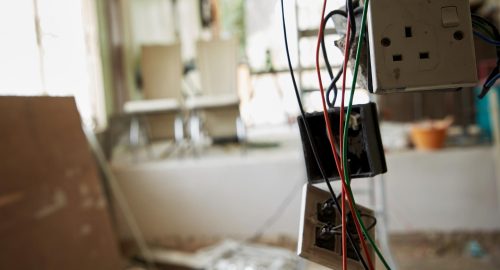Knob and tube electrical wiring is an old-fashioned system used in homes built before the 1950s. While once standard, it has become outdated due to modern electrical demands and safety standards. Understanding what knob and tube wiring is and how it functions is crucial for homeowners living in older properties. This knowledge can help you make informed decisions about necessary upgrades and ensure your home remains safe and efficient.
What is Knob and Tube Electrical Wiring?
Knob and tube electrical wiring is an early method used to install electrical systems in homes. It was common from the 1880s to the late 1940s. This system consists of two parts: ceramic knobs and ceramic tubes. The ceramic knobs are used to anchor the wires, while the ceramic tubes protect the wires as they pass through wooden framing, such as joists or studs.
The wiring itself includes black and white wires that run separately, unlike modern wiring where both wires are enclosed in a single sheath. This separation can make it easier to spot the wires, but it also means there is no ground wire, which is a safety feature in modern electrical systems.
Knob and tube wiring was sufficient for electrical demands when it was first installed. However, it is not designed to handle the power needs of modern homes. Over time, the insulation covering the wires can deteriorate, leading to a higher risk of electrical fires. Because of these limitations, many homeowners choose to upgrade to more current electrical systems to ensure safety and reliability.
Identifying Knob and Tube Wiring in Your Home
Identifying knob and tube electrical wiring in your home can help you understand what upgrades might be necessary. One of the easiest places to check is the basement or attic, where the wiring is often exposed. Look for ceramic knobs attached to the joists or ceramic tubes running through holes in wooden structural components.
Another way to identify this type of wiring is to examine the electrical outlets and switches. Older two-prong outlets, as opposed to modern three-prong grounded outlets, can be a sign that your home has knob and tube wiring. Removing the cover plates and looking inside can show if there are black and white wires that are not enclosed in a single sheath.
You can also look for signs of outdated electrical panel boxes. If your home still has an old fuse box instead of a modern circuit breaker panel, it is another indicator that your home may have knob and tube wiring. Consulting with our professionals can provide a definitive identification and offer a clear path toward updating your home’s electrical system.
Understanding these visual clues can help you determine the presence of knob and tube wiring and take steps to upgrade to a safer, more efficient system.
Risks Associated with Knob and Tube Wiring
Knob and tube electrical wiring carries several risks that modern homeowners need to be aware of. One major concern is the lack of grounding. Modern electrical systems use a ground wire to direct any stray electricity safely into the ground. Knob and tube wiring lacks this essential feature, increasing the risk of electrical shock or fire.
Another risk is the deterioration of the insulation around the wires. Over time, the insulation material can become brittle and fall off, exposing the wires. This exposure can lead to short circuits and electrical fires, especially when the wiring is near combustible materials like wooden beams or insulation.
Additionally, knob and tube wiring is not designed to handle the electrical load of modern appliances and electronics. Overloading the system can cause the wires to overheat, creating a fire hazard. The increased demand from various high-wattage devices can strain this outdated system beyond its capacity, making it unsafe to use.
Identifying and addressing these risks is crucial for the safety of your home. Consulting with our professionals can help you assess the condition of your existing wiring and make informed decisions about necessary upgrades.
Steps to Upgrade from Knob and Tube Electrical Wiring
Upgrading from knob and tube electrical wiring involves several important steps. First, conduct a thorough inspection of the existing wiring. Our professionals will examine the current state of the wiring, identify any immediate hazards, and create a plan for the upgrade.
Next, prepare for the installation of new, modern wiring. This process typically involves removing the old knob and tube components and replacing them with updated, code-compliant materials. Our technicians will ensure that the new wiring meets all safety standards and can handle your home’s electrical demands.
Third, update the electrical panel if necessary. Many homes with knob and tube wiring also have outdated electrical panels that need to be replaced. A modern panel will include circuit breakers and grounding, enhancing the overall safety and efficiency of your electrical system.
Finally, test the new system to ensure it functions correctly. Our professionals will check the newly installed wiring and outlets, verifying that everything operates as expected. This ensures that your home is safe and ready to handle modern electrical loads.
Upgrading from knob and tube wiring is a significant but essential step in maintaining a safe and efficient home. Proper planning and professional execution can make this process smooth and successful.
Conclusion
Understanding the intricacies of knob and tube electrical wiring is essential for homeowners, especially those living in older homes. Recognizing this outdated system, identifying its risks, and knowing when to upgrade can prevent potential hazards and improve your home’s electrical efficiency. Regular inspections and timely upgrades ensure that your home remains safe and up-to-date with modern standards.
Knob and tube wiring pose particular challenges, but with the right steps, you can make your home safer and more efficient. After identifying the presence of knob and tube wiring, it’s crucial to assess the associated risks and decide on a comprehensive upgrade plan. This involves removing old components, installing new wiring, and ensuring everything meets current safety standards.
When DIY fixes aren’t enough, our team at Stafford Home Service Inc is ready to help. Our professionals have the expertise to handle all aspects of upgrading knob and tube electrical wiring in Minneapolis, ensuring your home is secure and efficient. Contact us today for all your electrical needs. Stay safe and modernize your home with our expert services.








